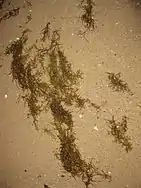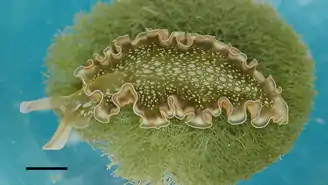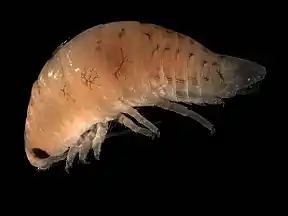Mesograzer
Mesograzers are defined as small invertebrate herbivores less than 2.5 cm in length (i.e., 1 inch), and can include juveniles of some larger species.[1][2] The feeding behaviour of these small invertebrate herbivores is what classifies them as mesograzers.[1] They are commonly found abundantly on Microalgae, seagrass beds, giant kelp, and coral reefs globally, since these are their main food sources and habitats.[3][4][5][6] Their foraging behaviour is grazing on the organism they are living on, where there are typically masses reaching tens of thousands of mesograzers per meter of habitat.[3] They experience predation from micro-carnivorous fish that help regulate the population of kelp and other common food sources of mesograzers by controlling the population of mesograzers; consequently, grazing is an important process linking aquatic vegetation to higher trophic level.[7] Mesograzers show important top-down effect on marine communities, depending on the diversity and presence of predators.[6][3] Mesograzers are typically overlooked in scientific research however their foraging effects have been suggested to have extreme effects on the population of their common food sources.[3] They both positively and negatively affect macroalgal performance and productivity through grazing on algal (i.e., negative effect), or through removing epiphytes (i.e., positive effects).[3] Mesograzers typically exist in spaces lacking enemies by inhabiting, therefore consuming, marine vegetation which are defended against more mobile, larger consumers through chemical defenses.[8]
Mesograzers are quite common in the marine environment, common examples of mesograzers are small Gastropoda, Amphipoda, Isopoda, and small Crustaceans.[3][9][10]
Diet

_holdfast.jpg.webp)
Mesograzers consume a variety of marine vegetation. They typically use the same marine plant as both their habitat and food source.[3] Many mesograzers have been found on sea grass beds.[4] They are also quite known for destroying large populations of giant kelp, as this is another popular source for mesograzers.[5] Other common food sources of mesograzers are coral reefs and macroalgal.[3][6] They can be found living and feeding on these marine plants worldwide. Mesograzers have even been shown to consume invasive species of microalgae.[11]
Ecological role
There is little understanding of mesograzers ecological role.[3] Examination of mesograzer outbreaks in natural, as well as aquacultural settings suggests that they have the potential to alter the abundance of algal.[3] However, the rarity of such events infers that the impact of mesograzers is more than likely insignificant.[3] Nonetheless, observations alone are not significant enough to quantify their ecological role.[3] Many researchers have tried to determine community-wide effects of mesograzers in laboratory studies.[3] This has proven to be difficult due to high spatial and temporal variation in the density of mesograzers, variation in feeding behaviour, along with variable relationships between plant fitness and mesograzers consumption rates.[3] These factors make it difficult to replicate a mesograzers natural environment in a laboratory setting.[3] This difficulty lends to the low understanding of mesograzers ecological role in marine communities.[3] The strongest evidence for mesograzers altering a marine community thus far demonstrates the ability of mesograzers to limit populations of algal epiphytes, which in turn shows benefits for sea grass.[3] However, there is a high need for further field research in this area.[3]
In gastropods

Grazing herbivorous gastropods are known as mesograzers.[3] They are commonly known to graze upon epilithic microalgae on rocky shores.[13] The grazing gastropods in these regions are exposed to daily exposure to air, as well as immersion in seawater, due to the tides.[13] Intertidal grazing gastropods can therefore get their food from epilithic microalgae and planktonic microalgae deposited during the tidal shift.[3] However, they obtain most of their food by grazing on the microalgae on the rock surface.[13] The algae availability along with feeding capability will determine the diets of the gastropod grazers on rocky shores.[13] Different gastropod grazers with varying radula morphology are known to use the same food source.[13] A possible explanation is that the gastropods may find differentiating between the various types of microalgae in their environment quite difficult.[13]
The marine vegetation consumed by grazing gastropods occasionally produces chemical deterrents to prevent mesograzers from feeding on them.[10] Different gastropod grazers elicit different plant responses.[10]
In crustaceans
Many crustacean species depend largely on animals as their food source, however others feed on pure algal diets (e.g., cyclopoid).[14] Different species of cyclopoid have various mouth parts.[14] This affects if they are grazers or predators, and if grazers, what vegetation they will prefer to graze on.[14] Temperature also has an effect on the grazing behaviour of certain small crustaceans.[15] The relationship between algal and grazer typically shifts with the seasons.[14]

Isopoda
Isopoda are an order of crustacean commonly known as mesograzers, due to their general small size and grazing herbivorous feeding behaviour.[7] The mechanisms affecting their habitat choice and grazing in sea grass meadows is affected by the latitude.[7] For isopod grazers, food type is considered a universal mechanism in determining the presence of these grazers on sea grass meadows.[7] Food is more important than shelter, in the absence of predators, regarding habitat choice.[7] Many factors, such as food quality, location, predation, plant morphology, and physiology of the isopod affect food, thus habitat choice.[7] Isopod grazers typically respond to substances excreted by their food source, particu00larly epiphytes alone do not attract isopods (e.g., snails).[7]
Amphipoda
Amphipoda are an order of crustacean that typically graze on algae, considering them mesograzers.[16] Due to global stressors, the population main food sources for amphipods, such as algae, have seen some fluctuation.[16] To ensure they are feeding on the best algae, amphipods have many strategies to picking algae to graze on.[16] To optimize their diet they choose the most nutritive algae, or they increase their consumption rate and/or absorption efficiency while grazing on less nutrient rich algae.[16] These amphipod mesograzers use their host vegetation as both food and habitat, therefore the extent of their impact on benthic communities is related to patterns of host use by these consumers.[17] Food and shelter have been defined as the main factors determining these amphipods' host.[17]
References
- Beermann, Jan; Boos, Karin; Gutow, Lars; Boersma, Maarten; Peralta, Ana Carolina (2018-03-01). "Combined effects of predator cues and competition define habitat choice and food consumption of amphipod mesograzers". Oecologia. 186 (3): 645–654. Bibcode:2018Oecol.186..645B. doi:10.1007/s00442-017-4056-4. ISSN 0029-8549. PMC 5829112. PMID 29335795.
- Mar Ecol Prog Ser 207: 227–241, 2000
- Poore, Alistair G. B.; Campbell, Alexandra H.; Steinberg, Peter D. (2009-01-01). "Natural densities of mesograzers fail to limit growth of macroalgae or their epiphytes in a temperate algal bed". Journal of Ecology. 97 (1): 164–175. doi:10.1111/j.1365-2745.2008.01457.x. ISSN 1365-2745.
- Davenport, Andrew C.; Anderson, Todd W. (2007). "Positive Indirect Effects of Reef Fishes on Kelp Performance: The Importance of Mesograzers". Ecology. 88 (6): 1548–1561. doi:10.1890/06-0880. JSTOR 27651261. PMID 17601146.
- Cruz-Rivera, Edwin; Friedlander, Michael (2011). "Feeding preferences of mesograzers on aquacultured Gracilaria and sympatric algae". Aquaculture. 322–323 (323): 218–222. doi:10.1016/j.aquaculture.2011.09.035. PMC 3375704. PMID 22711945.
- Machado, Glauco Barreto de Oliveira; Siqueira, Silvana Gomes Leite; Leite, Fosca Pedini Pereira (2017). "Abundance, performance, and feeding preference of herbivorous amphipods associated with a host alga-epiphyte system". Journal of Experimental Marine Biology and Ecology. 486: 328–335. doi:10.1016/j.jembe.2016.10.030.
- Boström, Christoffer; Mattila, Johanna (1999). "The Relative Importance of Food and Shelter for Seagrass-Associated Invertebrates: A Latitudinal Comparison of Habitat Choice by Isopod Grazers". Oecologia. 120 (1): 162–170. Bibcode:1999Oecol.120..162B. doi:10.1007/s004420050845. JSTOR 4222371. PMID 28308048.
- Taylor, Richard B.; Steinberg, Peter D. (2005-11-01). "Host Use by Australasian Seaweed Mesograzers in Relation to Feeding Preferences of Larger Grazers". Ecology. 86 (11): 2955–2967. doi:10.1890/04-1480. ISSN 1939-9170.
- Cruz-Rivera, Edwin; Petsche, Cheryl; Hafez, Tamer (2017-06-01). "Detecting sex-related differences in mesograzer feeding experiments: An often overlooked source of intraspecific variation in herbivory". Limnology and Oceanography: Methods. 15 (6): 542–553. doi:10.1002/lom3.10179. ISSN 1541-5856.
- Steele, LaTina; Valentine, John F. (2015-03-30). "Seagrass deterrence to mesograzer herbivory: evidence from mesocosm experiments and feeding preference trials". Marine Ecology Progress Series. 524: 83–94. Bibcode:2015MEPS..524...83S. doi:10.3354/meps11127. ISSN 0171-8630.
- Jiménez, Rocío Suárez; Hepburn, Christopher D.; Hyndes, Glenn A.; McLeod, Rebecca J.; Taylor, Richard B.; Hurd, Catriona L. (2015-12-01). "Do native subtidal grazers eat the invasive kelp Undaria pinnatifida?". Marine Biology. 162 (12): 0. doi:10.1007/s00227-015-2757-y. ISSN 0025-3162.
- Middlebrooks, Michael L.; Pierce, Sidney K.; Bell, Susan S. (2011-07-20). "Foraging Behavior under Starvation Conditions Is Altered via Photosynthesis by the Marine Gastropod, Elysia clarki". PLOS ONE. 6 (7): e22162. Bibcode:2011PLoSO...622162M. doi:10.1371/journal.pone.0022162. ISSN 1932-6203. PMID 21799783.
- Ding, Meng-wen; Wang, Zhao-kai; Dong, Yun-wei (2018). "Food availability on the shore: Linking epilithic and planktonic microalgae to the food ingested by two intertidal gastropods". Marine Environmental Research. 136: 71–77. doi:10.1016/j.marenvres.2018.02.005. PMID 29478767.
- Not Available, Not Available; Not Available, Not Available (2001-06-01). "Indirect, size-dependent effects of crustacean mesograzers on the Rhodophyta Gracilaria verrucosa (Hudson) Papenfuss: evidence from a short-term study in the Lesina Lagoon (Italy)". Marine Biology. 138 (6): 1163–1173. doi:10.1007/s002270100545. ISSN 0025-3162.
- Pearson, Ryan M.; Jinks, Kristin I.; Brown, Christopher J.; Schlacher, Thomas A.; Connolly, Rod M. (2018). "Functional changes in reef systems in warmer seas: Asymmetrical effects of altered grazing by a widespread crustacean mesograzer". Science of the Total Environment. 644: 976–981. Bibcode:2018ScTEn.644..976P. doi:10.1016/j.scitotenv.2018.07.051. hdl:10072/382266. ISSN 0048-9697.
- Benítez, Samanta; Duarte, Cristian; López, Jorge; Manríquez, Patricio H.; Navarro, Jorge M.; Bonta, Cesar C.; Torres, Rodrigo; Quijón, Pedro A. (2016). "Ontogenetic variability in the feeding behavior of a marine amphipod in response to ocean acidification". Marine Pollution Bulletin. 112 (1–2): 375–379. doi:10.1016/j.marpolbul.2016.07.016.
- Machado, Glauco Barreto de Oliveira; Siqueira, Silvana Gomes Leite; Leite, Fosca Pedini Pereira (2017). "Abundance, performance, and feeding preference of herbivorous amphipods associated with a host alga-epiphyte system". Journal of Experimental Marine Biology and Ecology. 486: 328–335. doi:10.1016/j.jembe.2016.10.030.
- Marine Ecology Progress Series 207: 227–241, 2000.
- correct citation: Wright J.T., de Nys R., Steinberg P.D. 2000 Geographic-scale patterns of algal chemical defence: the relationship between quantitative variation in secondary metabolites, herbivores and epiphytes. Marine Ecology Progress Series 207, 227-241.